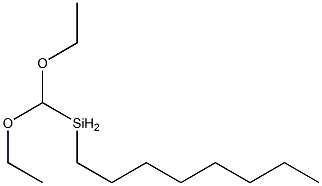N-OCTADECYLTRICHLOROSILANE
Synonym(s):Octadecyltrichlorosilane
- CAS NO.:112-04-9
- Empirical Formula: C18H37Cl3Si
- Molecular Weight: 387.93
- MDL number: MFCD00000484
- EINECS: 203-930-7
- SAFETY DATA SHEET (SDS)
- Update Date: 2025-09-25 17:15:13

What is N-OCTADECYLTRICHLOROSILANE?
Chemical properties
Colorless clear liquid
The Uses of N-OCTADECYLTRICHLOROSILANE
n-Octadecyltrichlorosilane is used in semiconductor industry to form self-assembled monolayer thin films on silicon dioxide substrates. Used in molecular electronics, as thin insulating gates in Metal-Insulator-Semiconductor Field-Effect Transistors. It is also used in platinum catalyzed synthesis.
General Description
A colorless liquid with a pungent odor. Flash point of 193°F. Decomposed by water to hydrochloric acid with the evolution of heat. Corrosive to metals and tissue. Used to make various silicon containing compounds.
Reactivity Profile
Chlorosilanes, such as N-OCTADECYLTRICHLOROSILANE, are compounds in which silicon is bonded to from one to four chlorine atoms with other bonds to hydrogen and/or alkyl groups. Chlorosilanes react with water, moist air, or steam to produce heat and toxic, corrosive fumes of hydrogen chloride. They may also produce flammable gaseous H2. They can serve as chlorination agents. Chlorosilanes react vigorously with both organic and inorganic acids and with bases to generate toxic or flammable gases.
Health Hazard
TOXIC; inhalation, ingestion or contact (skin, eyes) with vapors, dusts or substance may cause severe injury, burns or death. Contact with molten substance may cause severe burns to skin and eyes. Reaction with water or moist air will release toxic, corrosive or flammable gases. Reaction with water may generate much heat that will increase the concentration of fumes in the air. Fire will produce irritating, corrosive and/or toxic gases. Runoff from fire control or dilution water may be corrosive and/or toxic and cause pollution.
Fire Hazard
Combustible material: may burn but does not ignite readily. Substance will react with water (some violently) releasing flammable, toxic or corrosive gases and runoff. When heated, vapors may form explosive mixtures with air: indoors, outdoors and sewers explosion hazards. Most vapors are heavier than air. They will spread along ground and collect in low or confined areas (sewers, basements, tanks). Vapors may travel to source of ignition and flash back. Contact with metals may evolve flammable hydrogen gas. Containers may explode when heated or if contaminated with water.
Safety Profile
A corrosive irritant to skin, eyes, and mucous membranes. Reacts with water or steam to produce toxic and corrosive fumes. When heated to decomposition it emits toxic fumes of Cl-. See also CHLOROSILANES.
Purification Methods
Purify it by fractional distillation at high vacuum. [Winstein & Seubold J Am Chem Soc 69 2916 1947, Beilstein 4 IV 4256.]
Properties of N-OCTADECYLTRICHLOROSILANE
| Melting point: | 22°C |
| Boiling point: | 223 °C10 mm Hg(lit.) |
| Density | 0.984 g/mL at 25 °C(lit.) |
| vapor density | >1 (vs air) |
| vapor pressure | <5 mm Hg ( 20 °C) |
| refractive index | n |
| Flash point: | 193 °F |
| storage temp. | Store below +30°C. |
| solubility | Chloroform (Sparingly), Dichloromethane (Slightly) |
| form | A liquid |
| color | White or Colorless to Light yellow |
| Specific Gravity | 0.984 |
| Water Solubility | Decomposes in water. |
| Sensitive | Moisture Sensitive |
| Hydrolytic Sensitivity | 8: reacts rapidly with moisture, water, protic solvents |
| BRN | 1778847 |
| Stability: | Stable. Reacts violently with water. Incompatible with strong acids, strong bases, strong oxidizing agents. Air-sensitive. Combustible. |
| CAS DataBase Reference | 112-04-9(CAS DataBase Reference) |
| NIST Chemistry Reference | Silane, trichlorooctadecyl-(112-04-9) |
| EPA Substance Registry System | Silane, trichlorooctadecyl- (112-04-9) |
Safety information for N-OCTADECYLTRICHLOROSILANE
| Signal word | Danger |
| Pictogram(s) |
 Corrosion Corrosives GHS05 |
| GHS Hazard Statements |
H314:Skin corrosion/irritation |
| Precautionary Statement Codes |
P280:Wear protective gloves/protective clothing/eye protection/face protection. P301+P330+P331:IF SWALLOWED: Rinse mouth. Do NOT induce vomiting. P303+P361+P353:IF ON SKIN (or hair): Remove/Take off Immediately all contaminated clothing. Rinse SKIN with water/shower. P305+P351+P338:IF IN EYES: Rinse cautiously with water for several minutes. Remove contact lenses, if present and easy to do. Continuerinsing. |
Computed Descriptors for N-OCTADECYLTRICHLOROSILANE
| InChIKey | PYJJCSYBSYXGQQ-UHFFFAOYSA-N |
New Products
4,4-Difluoropiperidine hydrochloride tert-butyl 9-methoxy-3-azaspiro[5.5]undecane-3-carboxylate Indole Methyl Resin N-Isopropylurea N,N-Dicyclohexylcarbodiimide(DCC) MELDRUMS ACID 5-METHYLISOXAZOLE-4-CARBOXYLIC ACID Magnessium Bis glycinate Zinc ascorbate 1-bromo-2-butyne 2-acetamidophenol 9(10H)-anthracenone Erythrosin B, 4-Piperidinopiperidine 2-((4-morpholinophenylamino) (methylthio) methylene) malononitrile 2,4-dihydroxybenzaldehyde 3-(4-morpholinophenylamino)-5-amino-1H-pyrazole-4-carbonitrile Methyl 2-methylquinoline-6-carboxylate 2,6-dichloro-4-nitropyridine 4-Bromo-2-chlorobenzonitrile 2-(benzylamino)acetic acid hydrochloride 4-(tert-Butoxycarbonylamino)but- 2-ynoic acid 3,4-dihydro-2H-benzo[b][1,4]dioxepine 1-Phenyl-1-cycloprppanecarboxylicacidRelated products of tetrahydrofuran








You may like
-
 n-Octadecyltrichlorosilane, 95% CAS 112-04-9View Details
n-Octadecyltrichlorosilane, 95% CAS 112-04-9View Details
112-04-9 -
 Trichlorooctadecylsilane (>99.0%) CAS 112-04-9View Details
Trichlorooctadecylsilane (>99.0%) CAS 112-04-9View Details
112-04-9 -
 Trichlorooctadecylsilane CAS 112-04-9View Details
Trichlorooctadecylsilane CAS 112-04-9View Details
112-04-9 -
 Trichloro(octadecyl)silane CAS 112-04-9View Details
Trichloro(octadecyl)silane CAS 112-04-9View Details
112-04-9 -
 3-(4-amino-1-oxoisoindolin-2-yl)-1-methylpiperidine-2,6-dione 98%View Details
3-(4-amino-1-oxoisoindolin-2-yl)-1-methylpiperidine-2,6-dione 98%View Details -
 20677-73-0 (2,2-diethoxyethyl)methylamine 98%View Details
20677-73-0 (2,2-diethoxyethyl)methylamine 98%View Details
20677-73-0 -
 3-(4-(hydroxyamino)-1-oxoisoindolin-2-yl)piperidine-2,6-dione 98%View Details
3-(4-(hydroxyamino)-1-oxoisoindolin-2-yl)piperidine-2,6-dione 98%View Details -
 57381-49-4 2-bromo-4-chlorobenzonitrile 98%View Details
57381-49-4 2-bromo-4-chlorobenzonitrile 98%View Details
57381-49-4
